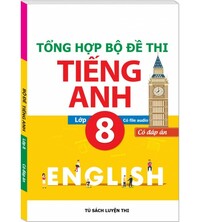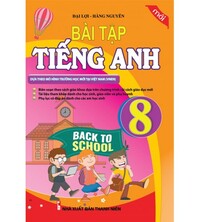Vocabulary & Grammar - Unit 5. Our customs and traditions - SBT Tiếng Anh 8 Global Success
1. Look at the pictures and complete the phrases. The first letters are given to you. 2. Choose the correct answer A, B, or C to complete each sentence. 3. Complete the text with the words from the box. 4. Complete each sentence with a, an, the, or 0 (zero article). 5. Some of the lines in the text below have an article which is incorrectly used. If the line has a wrong article, circle it and write the correct one on the right of the line. If the line is correct, put a tick (V).
Bài 1
1. Look at the pictures and complete the phrases. The first letters are given to you.
(Nhìn vào những bức tranh và hoàn thành các cụm từ. Những chữ cái đầu tiên được cho sẵn.)

Lời giải chi tiết:
1. an ornamental tree (cây cảnh)
2. a blooming flower (hoa nở)
3. a communual house (đình làng)
4. a bamboo pole (cọc tre)
5. bad spirits (linh hồn xấu xa)
6. food offerings (thức ăn cúng dường)
7. martial arts (võ thuật)
8. festival goers (người đi lễ hội)
Bài 2
2. Choose the correct answer A, B, or C to complete each sentence.
(Chọn đáp án đúng A, B, hoặc C để hoàn thành mỗi câu.)
1. In many cultures, a _____ represents youth, beauty, and pleasure.
A. blooming flower
B. communal house
C. bamboo pole
2. _____ such as kumquat trees, peach blossoms, and apricot flowers are popular at Tet.
A. Blooming flower
B. Vegetables
C. Ornamental trees
3. Traditionally, the _____ in a village is a place for villagers to meet or worship.
A. festival
B. market
C. communal house
4. Every year, the Bulgarians hold the Surva Festival to chase away _____.
A. bad spirits
B. festival goers
C. martial artists
5. In many Vietnamese villages, people put up a _____ in the yard of the communal house to welcome Tet.
A. fight
B. barrier
C. bamboo pole
6. During Tet, the Kinh often prepare traditional _____ such as banh chung and boiled chicken to worship their ancestors.
A. decorative items
B. food offerings
C. spirits
7. Last year, thousands of festival _____ participated in the Lim Festival in Tien Du District.
A. comers
B. goers
C. movers
8. Learning _____ can help build physical strength and improve confidence.
A. martial arts
B. physics
C. chemistry
Lời giải chi tiết:

1. A
In many cultures, a blooming flowers represents youth, beauty, and pleasure.
(Trong nhiều nền văn hóa, hoa nở tượng trưng cho tuổi trẻ, sắc đẹp và niềm vui.)
Giải thích:
A. blooming flower (np): hoa nở
B. communal house (np): đình
C. bamboo pole (np): cọc tre
2. C
Ornamental trees such as kumquat trees, peach blossoms, and apricot flowers are popular at Tet.
(Các loại cây cảnh như cây quất, hoa đào, hoa mai được ưa chuộng trong dịp Tết.)
Giải thích:
A. Blooming flower (np): hoa nở
B. Vegetables (n): rau
C. Ornamental trees (np): cây cảnh
3. C
Traditionally, the communal house in a village is a place for villagers to meet or worship.
(Theo truyền thống, đình làng là nơi để dân làng hội họp, thờ cúng.)
Giải thích:
A. festival (n): lễ hội
B. market (n): chợ
C. communal house (np): đình làng
4. A
Every year, the Bulgarians hold the Surva Festival to chase away bad spirits.
(Hàng năm, người Bulgaria tổ chức Lễ hội Surva để xua đuổi tà ma.)
Giải thích:
A. bad spirits (np): tà ma
B. festival goers (np): người đi lễ hội
C. martial artists (np): võ sĩ
5. C
In many Vietnamese villages, people put up a bamboo pole in the yard of the communal house to welcome Tet.
(Ở nhiều làng quê Việt Nam, người ta dựng cọc tre trước sân đình để đón Tết.)
Giải thích:
A. fight (n): trận đánh
B. barrier (n): rào cản
C. bamboo pole (np): cọc tre
6. B
During Tet, the Kinh often prepare traditional food offerings such as banh chung and boiled chicken to worship their ancestors.
(Trong dịp Tết, người Kinh thường chuẩn bị các món ăn truyền thống như bánh chưng, gà luộc để cúng tổ tiên.)
Giải thích:
A. decorative items (np): đồ trang trí
B. food offerings (np): cúng dường đồ ăn
C. spirits (n): tinh thần
7. B
Last year, thousands of festival goers participated in the Lim Festival in Tien Du District.
(Năm ngoái, hàng nghìn người tham gia lễ hội đã tham gia Lễ hội Lim ở huyện Tiên Du.)
Giải thích:
A. comers (n): người đến
B. goers (n): người đi
C. movers (n): người vận chuyển
8. A
Learning martial arts can help build physical strength and improve confidence.
(Học võ có thể giúp rèn luyện sức mạnh thể chất và nâng cao sự tự tin.)
Giải thích:
A. martial arts (n): võ thuật
B. physics (n): vật lý
C. chemistry (n): hóa học
Bài 3
3. Complete the text with the words from the box.
(Hoàn thành văn bản với các từ trong hộp.)
|
break custom traditionally maintain practise traditions |
I think each family has their own customs and (1) _______. For example, my uncle's children always spend two weeks in the countryside in summer time. Holding a party on everyone's birthday is another custom they (2)_______. As for my family, it is becoming a (3) ________ for us to bake a special cake on the last Sunday of each month. We also have a home cinema night every Saturday when we enjoy a film together. For my extended family, (4) ______ we gather on the first day of the Lunar New Year.
In my opinion, it is good for families to (5) ______ from time to time, they can (6) _______ their traditions. However, with tradition and try something new to add variety to their lives.
Lời giải chi tiết:

I think each family has their own customs and (1) traditions. For example, my uncle's children always spend two weeks in the countryside in summer time. Holding a party on everyone's birthday is another custom they (2) practise. As for my family, it is becoming a (3) custom for us to bake a special cake on the last Sunday of each month. We also have a home cinema night every Saturday when we enjoy a film together. For my extended family, (4) traditionally we gather on the first day of the Lunar New Year.
In my opinion, it is good for families to (5) maintain from time to time, they can (6) break their traditions. However, with tradition and try something new to add variety to their lives.
Tạm dịch:
Tôi nghĩ mỗi gia đình có phong tục và truyền thống riêng. Ví dụ, các con của chú tôi luôn dành hai tuần ở nông thôn vào mùa hè. Tổ chức một bữa tiệc vào ngày sinh nhật của mọi người là một phong tục khác mà họ thực hiện. Đối với gia đình tôi, nó đã trở thành thông lệ để chúng tôi nướng một chiếc bánh đặc biệt vào Chủ nhật cuối cùng của mỗi tháng. Chúng tôi cũng có một buổi tối xem phim tại nhà vào thứ bảy hàng tuần khi chúng tôi cùng nhau thưởng thức một bộ phim. Đối với đại gia đình của tôi, theo truyền thống, chúng tôi tụ tập vào ngày đầu tiên của Tết Nguyên đán.
Theo tôi, gia đình duy trì theo thời gian là tốt, họ có thể phá vỡ truyền thống của họ. Tuy nhiên, với truyền thống và thử một cái gì đó mới để thêm đa dạng cho cuộc sống của họ.
Bài 4
4. Complete each sentence with a, an, the, or 0 (zero article).
(Hoàn thành mỗi câu với a, an, the hoặc 0. (mạo từ không).)
1. I lost my wallet on _____ last day of my stay in Paris.
2. What are some things I should know about _____ Vietnamese table manners?
3. We often stay at home on New Year's Eve but this year was _____ exception.
4. My village holds an annual festival that welcomes _____ thousands of festival goers.
5. We went to _____ Chinese restaurant last night.
Phương pháp giải:
- “a” thường đứng trước danh từ đếm được số ít, bắt đầu bằng một phụ âm.
- “an” thường đứng trước danh từ đếm được số ít bắt đầu bằng nguyên âm (e, u, i, o, a) hoặc âm “h” câm.
- “the” thường đứng trước danh từ khi:
+ vật thể hay nhóm vật thể là duy nhất hoặc được xem là duy nhất
+ danh từ này vừa được đề cập trước đó
+ danh từ này được xác bằng 1 cụm từ hoặc 1 mệnh đề
+ đặt trước một danh từ chỉ một đồ vật riêng biệt mà người nói và người nghe đều hiểu
+ trước so sánh nhất (đứng trước first, second, only..) khi các từ này được dùng như tính từ hoặc đại từ
- Không dùng mạo từ khi:
+ danh từ không đếm được hoặc trừu tượng
+ đưa ra tuyên bố chung chung
+ mô tả các hình thức vận tải chung
Lời giải chi tiết:

1. I lost my wallet on the last day of my stay in Paris.
(Tôi bị mất ví vào ngày cuối cùng ở Paris.)
2. What are some things I should know about 0 Vietnamese table manners?
(Một số điều tôi nên biết về cách cư xử trên bàn ăn của người Việt Nam là gì?)
3. We often stay at home on New Year's Eve but this year was an exception.
(Chúng tôi thường ở nhà vào đêm giao thừa nhưng năm nay là một ngoại lệ.)
4. My village holds an annual festival that welcomes 0 thousands of festival goers.
(Làng tôi tổ chức một lễ hội hàng năm đón hàng ngàn người đi lễ hội.)
5. We went to a Chinese restaurant last night.
(Chúng tôi đã đến một nhà hàng Trung Quốc tối qua.)
Bài 5
5. Some of the lines in the text below have an article which is incorrectly used. If the line has a wrong article, circle it and write the correct one on the right of the line. If the line is correct, put a tick (V).
(Một số dòng trong văn bản dưới đây có một mạo từ được sử dụng không chính xác. Dòng nào có bài viết sai thì khoanh tròn và viết bài đúng vào bên phải của dòng. Nếu dòng đúng, hãy đánh dấu (V).)

Phương pháp giải:
Lời giải chi tiết:

Hung King Temple Festival is one of the national public holidays of Viet Nam. The festival aims to remember and worship the Hung Kings, the first kings of the nation. It is often held between the first and the 10th day of the third lunar month. The main ceremony happens at Hung King Temple in Viet Tri City, Phu Tho Province. Each year, about four million festival goers arrive at Phu Tho to join the festivities. There are over 1,400 Hung King Temples across Viet Nam, so whether you visit the main temple in Phu Tho or not, you can be a part of the festivities at any place in the country.
Tạm dịch:
Lễ hội Đền Hùng là một trong những ngày quốc lễ của Việt Nam. Lễ hội nhằm tưởng nhớ và suy tôn các Vua Hùng, những vị vua đầu tiên của một dân tộc. Nó thường được tổ chức từ ngày 1 đến ngày 10 tháng 3 âm lịch. Phần lễ chính diễn ra tại Đền thờ Vua Hùng ở thành phố Việt Trì, tỉnh Phú Thọ. Mỗi năm có khoảng 4 triệu lượt người đến Phú Thọ trẩy hội. Có hơn 1.400 Đền thờ Vua Hùng trên khắp Việt Nam, vì vậy, cho dù bạn có đến thăm một ngôi đền chính ở Phú Thọ hay không, bạn có thể là một phần của lễ hội ở bất kỳ nơi nào trên đất nước.
Search google: "từ khóa + timdapan.com" Ví dụ: "Vocabulary & Grammar - Unit 5. Our customs and traditions - SBT Tiếng Anh 8 Global Success timdapan.com"







